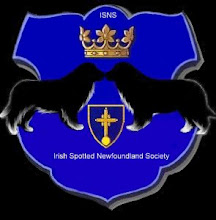
Gander, the Royal Riflemen's best friend
The big black dog was more than a mascot to Canadians fighting in Hong Kong, Bruce Ward reports. He died defending his comrades, who made sure Gander's name was etched in stone alongside theirs.
(The Ottawa Citizen, August 15, 2009)
Gander the dauntless war dog is where he belongs now, forever beside the soldiers he served as mascot of the Royal Rifles of Canada.
You'll see Gander's name if you look closely at the Hong Kong Veterans Memorial Wall, to be unveiled today at a moving dedication ceremony. The memorial wall sits on Sussex Drive, a few blocks from Parliament Hill.
The Hong Kong vets made certain that Gander's name was etched on the memorial among the 1,975 men and two women who fought for Canada against the Japanese forces that invaded Hong Kong in December 1941.
The soldiers who lived in squalid prisoner-of-war camps after the fall of the island had one unwavering policy: they shared any food that came into their possession. In the same spirit, they wanted Gander to share in their public remembrance, a six-metre-high concrete wall encased in granite.
Gander, a massive Newfoundland dog, fought at their side and died nobly in battle. The dog seized a live grenade in its jaws and ran toward the Japanese lines. Gander died in the explosion, but saved the lives of several wounded Canadian soldiers.
The Hong Kong contingent consisted of soldiers drawn from the Quebec-based Royal Rifles and the Winnipeg Grenadiers. They were the first Canadian infantry units to see combat in the Second World War.
When he was growing up in Belledune, N.B., Andy Flanagan often heard his father, Andrew "Ando" Flanagan, speak of Gander's exploits. Ando Flanagan enlisted in the winter of 1940, and was transferred with other Royal Rifles recruits to Newfoundland. They were stationed at Botwood, near the town of Gander.
The soldiers first encountered the dog, so large it was often mistaken for a bear, while in the town, Andy Flanagan says in a memoir about his dad, which he passed on to the Citizen. The dog was called Pal, and was a great favourite among the children. But Pal got in trouble when he scratched a child's face with his paw. It was an accident; Pal was only greeting the child with his usual exuberance. Pal's owner, worried he would be forced to put down the dog, gave him to the soldiers as their mascot.
The soldiers changed his name to Gander and took the dog to heart.
"Gander quickly adapted to military life," Flanagan writes. "He was elevated to sergeant faster than any enlisted man. On parade, he proudly marched up front, wearing his sergeant's stripes next to the regimental badge, attached to his harness."
Gander accompanied the Royal Rifles when they sailed to Hong Kong in the fall of 1941. The soldiers lived well for the first few weeks. The Hong Kong dollar was worth about 18 cents Canadian, so the soldiers had plenty of cash to spend on Hong Kong's vibrant nightclub scene. Some soldiers hired Chinese servants to keep their gear and boots gleaming, and even shave them in barracks.
Gander settled in, too, and could often be found sleeping in the shade of a veranda. Some Chinese workers on the base tried to abscond with Gander in hopes of turning him into dinner, the story goes. A snarling Gander rounded on them and drove them off, adding to his status among the soldiers.
When the invasion began the day after the Pearl Harbor attack, Gander was ready to fight. "Gander showed no fear of guns or bombs," Flanagan writes. "At the battle of Lye Mun Gap, he attacked Japanese troops as they landed near the Canadian section of the beach. During the fight, one caring soldier put Gander with his wounded men for his own protection. When a few Japanese soldiers ventured too close to his wounded comrades, Gander attacked and the enemy ran away shouting 'Black devil' in Japanese.
"Later during interrogation, Ando said the Japanese asked some Canadians about the black devil. Apparently, they thought the Canadians had trained black beasts to fight in battle."
In his death, Gander became more than a mascot, Flanagan writes. "Gander became a source of pride and encouragement for the Canadians who were captured and spent almost four years in the notoriously cruel Japanese POW system. Gander was their inspiration."
In 2000, Gander was posthumously awarded the Dickin Medal, an award for "any animal displaying conspicuous gallantry and devotion to duty whilst serving with the British Commonwealth armed forces."
Gander's citation states:
"For saving the lives of Canadian infantrymen during the Battle of Lye Mun on Hong Kong Island in December, 1941. On three documented occasions, Gander, the Newfoundland mascot of the Royal Rifles of Canada, engaged the enemy as his regiment joined the Winnipeg Grenadiers, members of Battalion Headquarters 'C' Force and other Commonwealth troops in their courageous defence of the island. Twice Gander's attacks halted the enemy's advance and protected groups of wounded soldiers. In a final act of bravery the war dog was killed in action gathering a grenade. Without Gander's intervention, many more lives would have been lost in the assault."
Gander's medal is on permanent display in the Hong Kong section of the Canadian War Museum.
Ando Flanagan weighed 68 pounds when he came home in the fall of 1945. "The scars of battle and torture remained until his dying days," his son Andy writes. "He never complained, and he never missed an opportunity to tell Sergeant Gander's story. Ando faded away, without fear, on February 28, 1993."
The Ottawa Citizen





































1 comment:
Tears were pricking my eyes as I read this. Gander made the ultimate sacrifice for his friends. His memory should always be honoured.
Post a Comment